- 1Department of Biology, University of Florence, Florence, Italy
- 2Reparto Carabinieri Biodiversità, Arezzo, Italy
- 3CREA – Research Centre for Plant Protection and Certification (CREA-DC), Florence, Italy
The white-clawed crayfish Austropotamobius pallipes complex populations are decreasing in the Foreste Casentinesi, Monte Falterona and Campigna National Park (Central Italy), due to several factors, including illegal poaching, predatory fishes, drought, and invasive alien species. Recently, the Northern raccoon Procyon lotor has been reported to be present in the area of the National Park and has started to predate on the white-clawed crayfish. The aim of the study was to update the distribution and population status of A. pallipes in the reserves, other sites of the National Park, and surrounding areas to assess the potential effects of the raccoon. Crayfish were sampled by hand or by traps in 14 sites; sampled individuals were sexed and measured. Signs of raccoon presence (e.g., footprints and predated crayfish) were also recorded. Our study confirms the impact of raccoon on native crayfish: indeed, where the invasive mammal is present (six sites), crayfish disappeared, or their populations have been dramatically reduced in number, with a size distribution skewed towards juveniles. In two sites, close to urban settlements, fresh footprints of P. lotor and predated specimens of A. pallipes were also observed. Populations of crayfish are still abundant or even increasing as compared with samplings conducted in the past where raccoon is absent (five sites). Urgent actions (e.g., control of raccoons, and monitoring and restocking of A. pallipes populations if feasible and where possible) should be taken into account to guarantee the survival of this protected species.
Introduction
Freshwater environments are among the ecosystems most threatened by human activities, and several impacts on them lead to a crisis in freshwater biodiversity (Abell, 2002). In these ecosystems, freshwater crayfish (Crustacea: Decapoda: Astacidae) have a crucial key-role, as they act as bioindicators for water quality, keystone species in trophic webs, and ecological engineers (Reynolds et al., 2013). Recent declines in several crayfish species, caused by multiple factors, such as habitat modification, water pollution, and the invasion of alien species (e.g., Manenti et al., 2019), have highlighted the need to identify and recommend appropriate management conservation actions and policies (Richman et al., 2015).
The white-clawed crayfish Austropotamobius pallipes complex (hereafter referred as A. pallipes) is one of the most threatened crayfish species in Europe (Chucholl, 2016), characterized by declining population densities and restricted distribution (Alonso et al., 2000; Kozak et al., 2011; Mazza et al., 2011, 2017). This species usually inhabits permanent, clear, well-oxygenated, and moderately cold (with temperatures below 24°C) freshwater bodies (e.g., headwaters and streams), rich in submerged cobbles, rocks, tree roots, and detritus (Füreder et al., 2010). This K-selected species has a slow growth rate and a relatively long average life span (Aquiloni et al., 2010). Sexual maturity is reached relatively late (around 3 years), and fertility is low (50–200 eggs per female). Moreover, mating takes place only once per year in autumn and is followed by a long breeding period, until the spring/summer of the subsequent year, during which females hide in a shelter to take care first of the eggs and then of the juveniles (Aquiloni et al., 2010). All these listed features make this crayfish particularly vulnerable and, despite being listed in Annex II of the EU Directive on the Conservation of Habitats, Flora, and Fauna (92/43/EEC), in Appendix II of the Bern Convention, and being considered “endangered” on the Red List of the IUCN, its decline is still ongoing, caused by the joint action of multiple factors, such as habitat alteration, pollution, climate change, invasive alien crayfish, and disease spread (e.g., Alonso et al., 2000; Mazza et al., 2011, 2017).
Recently, among the several threats affecting this protected crayfish, the impact of the Northern raccoon Procyon lotor was reported in Central Italy, in the Foreste Casentinesi, Monte Falterona and Campigna National Park (Tuscany and Emilia-Romagna) (Boscherini et al., 2020; Boncompagni et al., 2021). This mammal is an opportunistic species native to Central America, the United States, and southern Canada. It was introduced to Eurasia in the 20th century for fur and as an exotic pet (Salgado, 2018). It is listed amongst the 100 worst invasive alien species in Europe due to the multiple and severe impacts (Salgado, 2018), and it is included in the list of invasive alien species of Union concern linked to the EU Regulation 1143/2014 on invasive alien species. In Italy, P. lotor has been recorded in eight regions, although reproductive populations only occur in Lombardy and in an area between Tuscany and Emilia-Romagna regions (e.g., Mori et al., 2015; Boscherini et al., 2020). Boncompagni et al. (2021) confirmed the omnivorous food habits of the Northern raccoon, in both the native and introduced ranges, and the evident signs of predation on A. pallipes in the Foreste Casentinesi National Park, already reported in Boscherini et al. (2020). In this protected area, the native crayfish is at risk due to several other factors, including illegal poaching, predatory fishes, and drought. Moreover, invasive alien species are becoming an important threat for the species. Indeed, since 2015, the presence of the invasive red swamp crayfish Procambarus clarkii (Mazza et al., 2011, 2017) has been reported at the border of the National Park, and it is contributing to the local sharp decline of the native clawed crayfish due to the spread of crayfish plague Aphanomyces astaci, already detected in the area (T. Pretto, pers. comm.). Moreover, the invasive population of the Northern raccoon is exponentially increasing in the National Park (Boscherini et al., 2020; Boncompagni et al., 2021). Thus, following the suggestions provided by Boncompagni et al. (2021), the purpose of our research was to update the distribution and population status of A. pallipes in the reserves, other sites of the National Park, and surrounding areas in order to assess the potential effects of the raccoon on the native crayfish and suggest management actions to limit its impacts. For the first time, this study monitored all the reserves of the National Park for the native crayfish: indeed, in the past, only some of them were sampled.
Materials and Methods
Study Area
The National Park of the “Foreste Casentinesi, Monte Falterona e Campigna” is a ca. 36,000-ha protected area in the Tuscan–Emilian Apennines (Central Italy). This area includes one of the most high-quality forested areas in Europe and a variety of animal and plant species of great conservation value. The natural reserves of the Park protect a 53-km2 forested area (Figure 1). These reserves are included within the Natura 2000 network and are completely covered by forests, with portions of old-growth forests (“Riserva Integrale di Sasso Fratino”). The main types of vegetation associations are mono-specific European beech Fagus sylvatica woodland on mountain tops, where residual secondary grasslands also occur. Mixed woodlands of silver fir Abies alba and European beech are present on warm and wet slopes; forests of oaks (Quercus cerris, Quercus pubescens, and Quercus petraea) and hornbeams Ostrya carpinifolia occur at the lowest altitudes (Petralia et al., 2019). Among carnivores, the gray wolf Canis lupus italicus and the European wildcat Felis silvestris silvestris are the apex predators. Small-sized carnivores include the red fox Vulpes vulpes, the European badger Meles meles, the stone marten Martes foina, the Western polecat Mustela putorius, and the least weasel Mustela nivalis. The pine marten Martes martes is present at low density only in the northern part of the National Park, outside the reserves (Bottacci, 2009; Ragni et al., 2015).
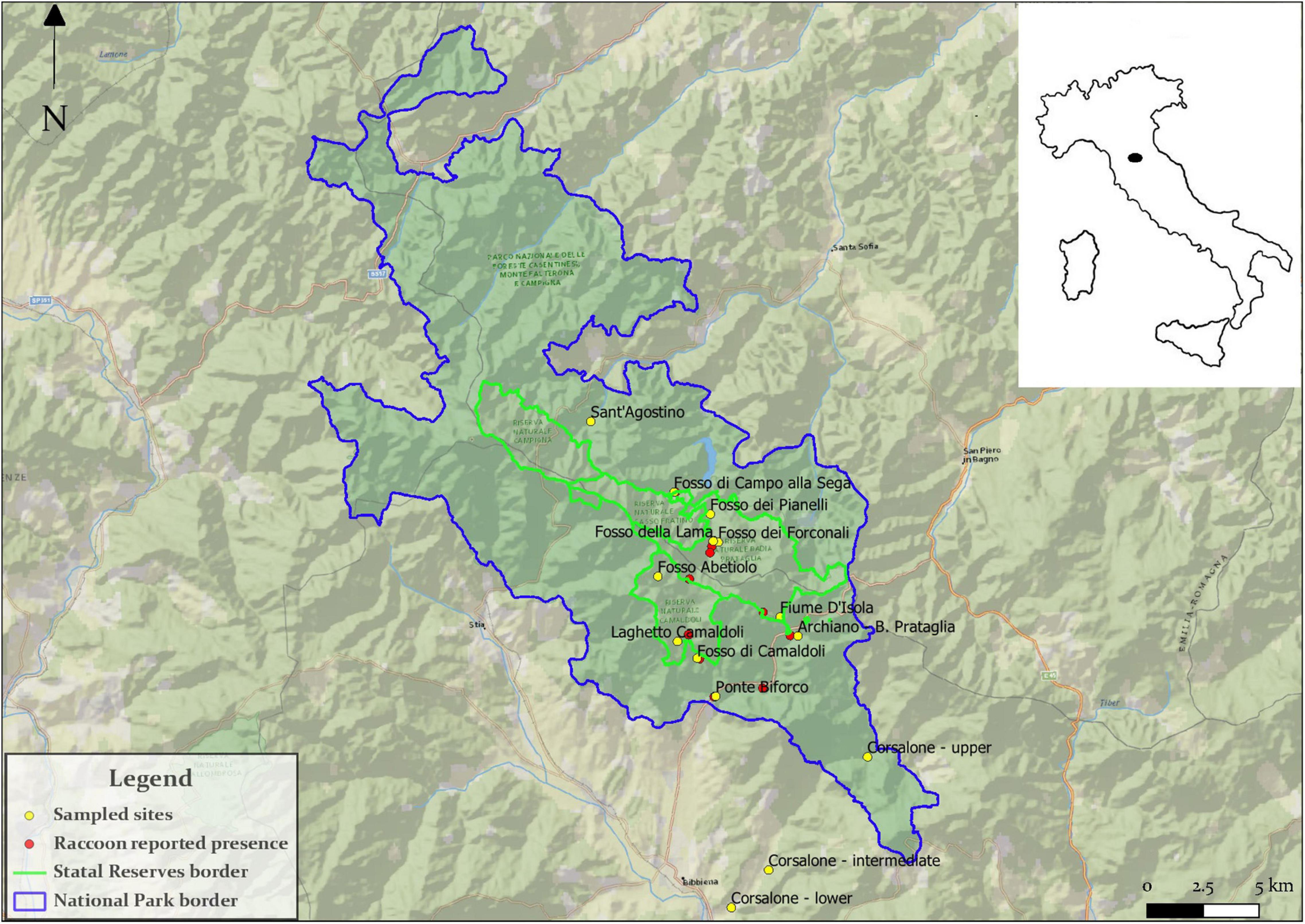
Figure 1. The sampled sites in the Foreste Casentinesi, Monte Falterona, and Campigna National Park, and surroundings.
Crayfish Sampling
Our samplings were conducted in 14 sites (Table 1). We selected sites within the natural reserves and with the presence of raccoon to assess the situation of native clawed crayfish in the natural reserves of the National Park (and some areas nearby) and in the presence of raccoon. From previous samplings, the presence of A. pallipes was known in 11 out of the 14 sampled sites. Three sites (Fosso Abetiolo, Fosso di Campo alla Sega, and Fiume d’Isola) were monitored for the first time during the present study. All the sites (except Laghetto di Metaleto, a small lake of 1,159 m2 located at 900 m a.s.l.) are small streams of second/third order located at an altitude range between 500 and 1,000 m a.s.l., composed of run and pools, with an average water depth of 50 cm, and a water temperature between 14 and 16°C. Crayfish and the native crab Potamon fluviatile also reported in the area were sampled from July to September 2020. Nighttime searching was conducted during the period of the species’ maximum activity (summer, one transect per site). Crayfish (and crabs) were searched by hand for an hour (for the streams, the investigated length ranged between 250 and 750 m) in all possible refuges: stones and leaf litter on the bottom of watercourses, and holes along the riverbanks. For Laghetto di Metaleto only, 10 baited crayfish traps were set for 24 h, because the hand search was not possible for its depth (2 m) and steep banks. Each captured individual was sexed and measured in the field using a digital caliper (accuracy, ±0.2 mm) [crayfish, cephalothorax length (CL) from the tip of the rostrum to the end of the cephalothorax; crab, maximum width of cephalothorax (CW)]. Crayfish with a CL ≤ 25 mm were considered as “juveniles,” whereas specimens with CL > 25 mm were reported as “mature crayfish” (Pratten, 1980). Measurements were conducted after disinfection of equipment to avoid disease transmission; then, crustaceans were immediately released at the same place of collection. The population abundance of A. pallipes was estimated using the method of “catch per unit effort” (CPUE), i.e., two researchers captured all the crayfish observed within an hour of hand searching and number of sampled crayfish on the number of used traps for Laghetto di Metaleto (Mazza et al., 2012). The number of dead and predated specimens by the Northern raccoon was reported. Consumption of adult crayfish by the Northern raccoon involves mostly the abdomen and part of the thorax, with head and chelae often left unconsumed on the riverbanks or riverbeds (Boscherini et al., 2020; Boncompagni et al., 2021). This modality of predation is indeed typical of raccoon and otter (which is not, however, present in the area), but not of the other mammals present in the National Park, as reported in Boncompagni et al. (2021). Signs of raccoon presence (i.e., their footprints) were also recorded. The presence of the raccoon was confirmed also by camera trapping data (data not showed). Sex and mature/juveniles were compared within watercourse by chi-squared test (statistic: χ2). CL of males and females within each site was compared by the non-parametric two-sample Mann–Whitney test (statistic: z). The level of significance at which the null hypothesis was rejected is α = 0.05. Text, Table 1 and Figures 2, 3 give medians and interquartile ranges (first-third quartiles).
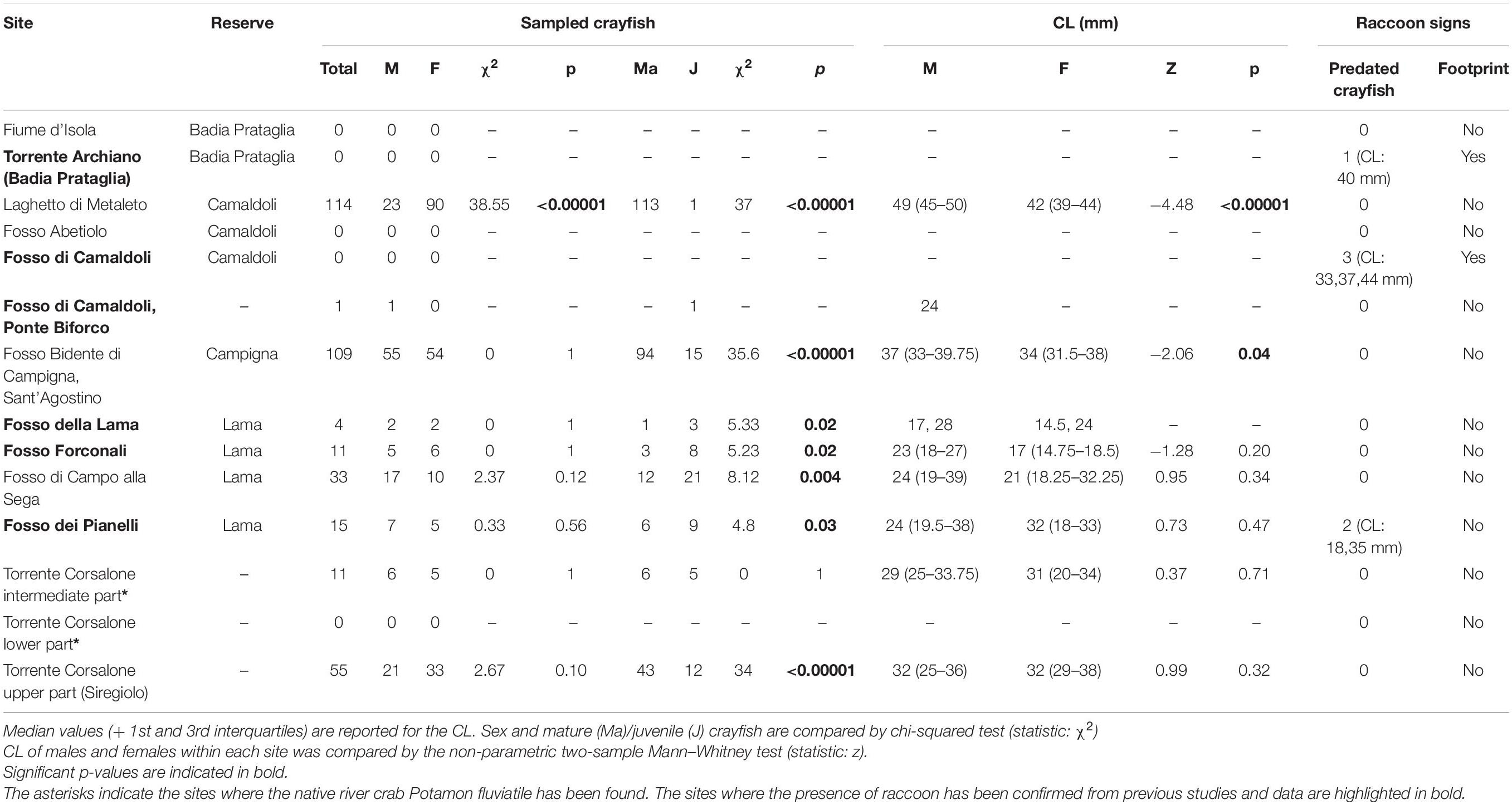
Table 1. Number, sex (M, male; F, female) and cephalothorax length (CL) in mm of sampled crayfish, the presence of raccoon signs, and the confirmed presence of raccoon per site.
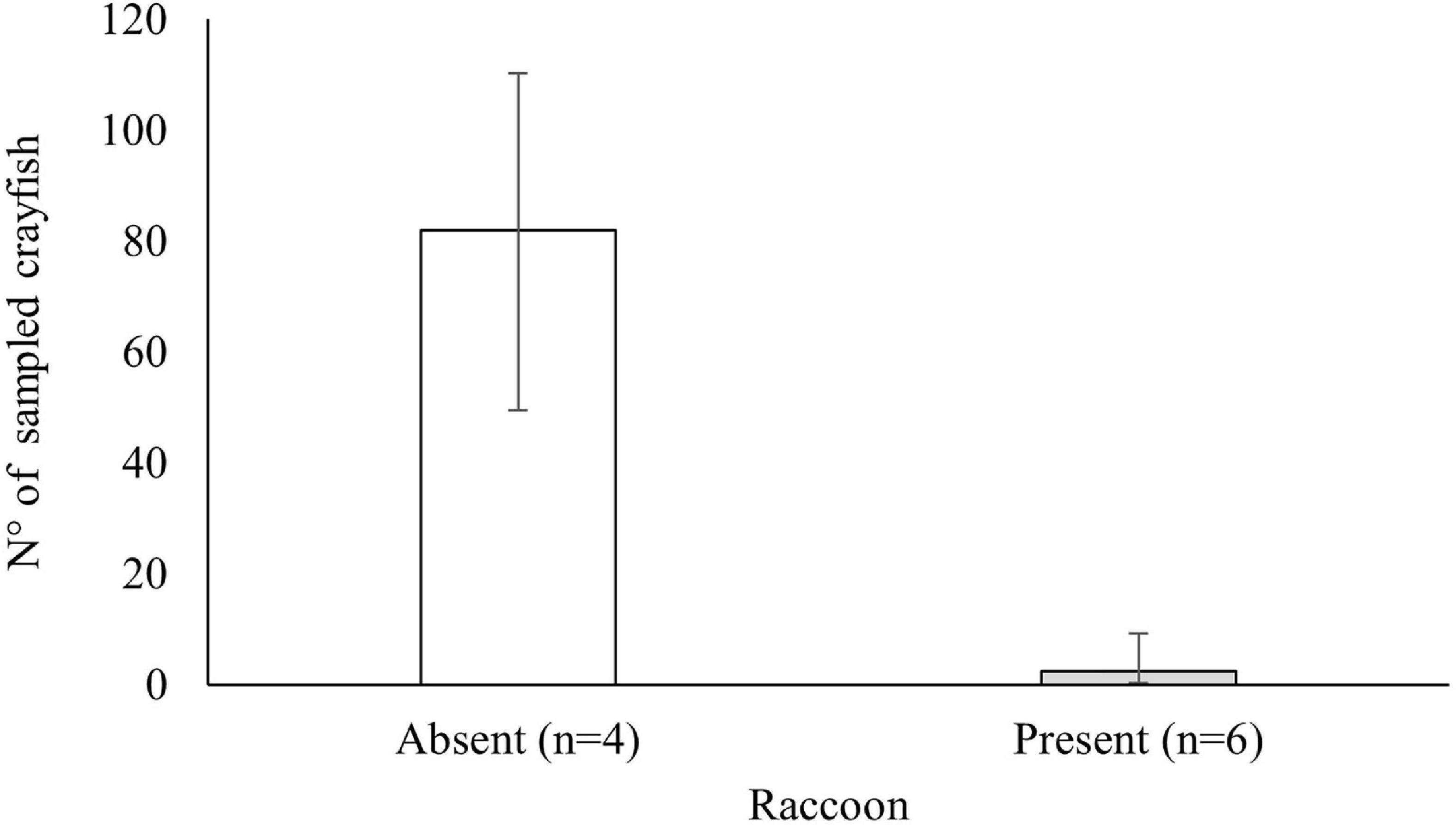
Figure 2. Number of crayfish sampled in sites with or without raccoon in the Foreste Casentinesi, Monte Falterona, and Campigna National Park. The three sites sampled for the first time (Fosso Abetiolo, Fosso di Campo alla Sega, and Fiume d’Isola) were not considered in the graph. Bars represent medians + 1st and 3rd interquartiles.
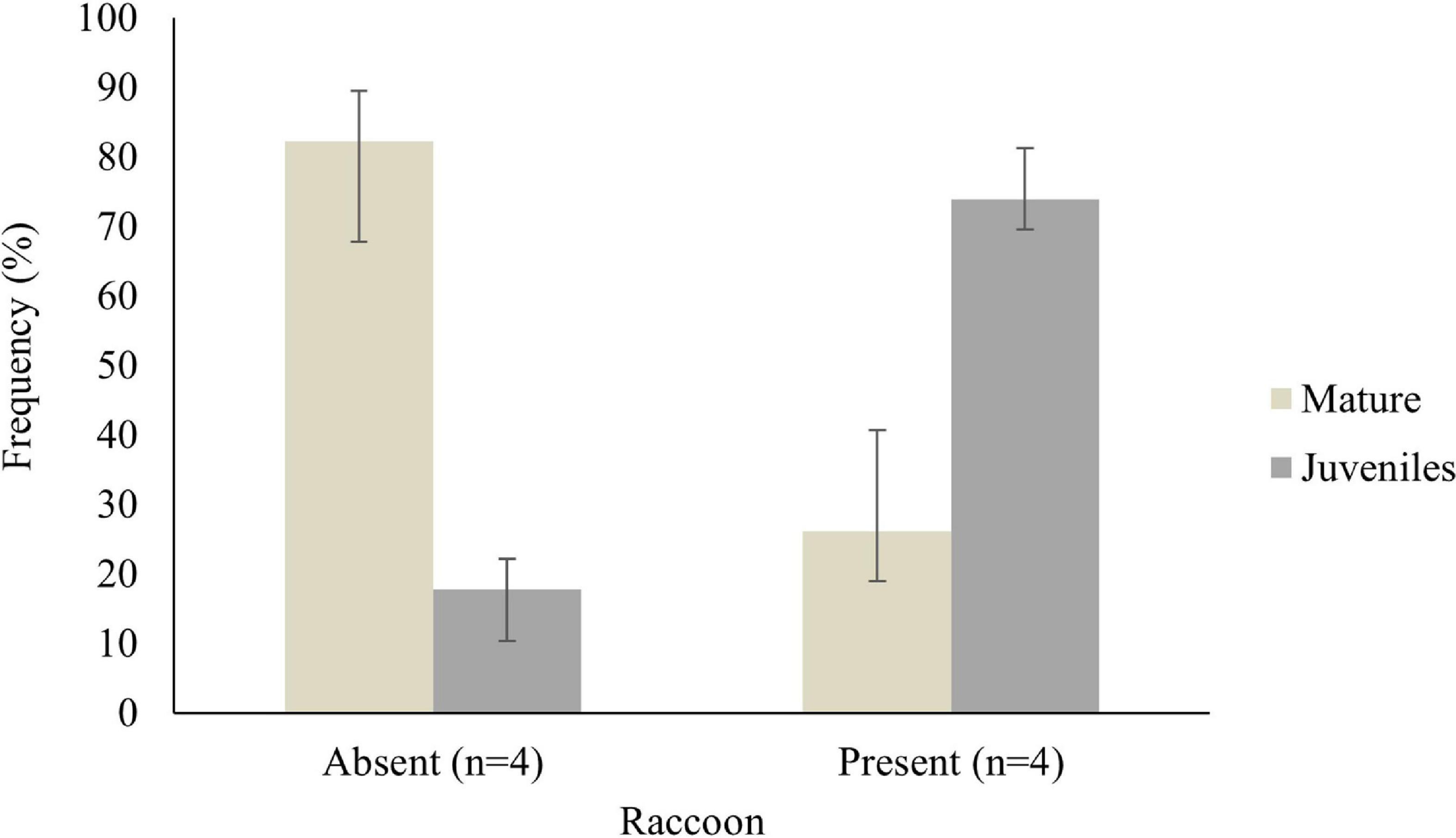
Figure 3. Frequency of mature and juvenile crayfish in sites with or without raccoon in the Foreste Casentinesi, Monte Falterona, and Campigna National Park. The three sites sampled for the first time (Fosso Abetiolo, Fosso di Campo alla Sega, and Fiume d’Isola) were not considered in the graph. Bars represent medians + 1st and 3rd interquartiles.
Results
Overall, CPUE was not high, excluding two sites (Laghetto di Metaleto and Bidente di Campigna). Mature and bigger individuals are more abundant when the raccoon is absent (Laghetto di Metaleto, Fosso Bidente di Campigna, Fosso di Campo alla Sega, and Torrente Corsalone, upper part; Table 1). Where the presence of raccoon is confirmed (six sites), crayfish were not present in two sites where they were present in the past, while in the other four sites, CPUE was very low, individual crayfish size was very small, and crayfish were mostly juveniles (Table 1 and Figures 2, 3). Moreover, in two sites, fresh footprints and predated specimens were observed, confirming the presence of raccoon (Figure 4 and Table 1). Sex ratio was balanced, except in Laghetto di Metaleto (Table 1). In the lower part of Corsalone, only the native crab was found: the sampled individuals were seven males and seven females with similar size: CW males = 41 (37.5–45) mm, CW females = 44 (39.5–46.5) mm (z = 0.38, p = 0.70). In the intermediate part of Corsalone, crayfish were found to co-occur with crab (one captured females of CW = 34 mm, two other individuals of similar size spotted).
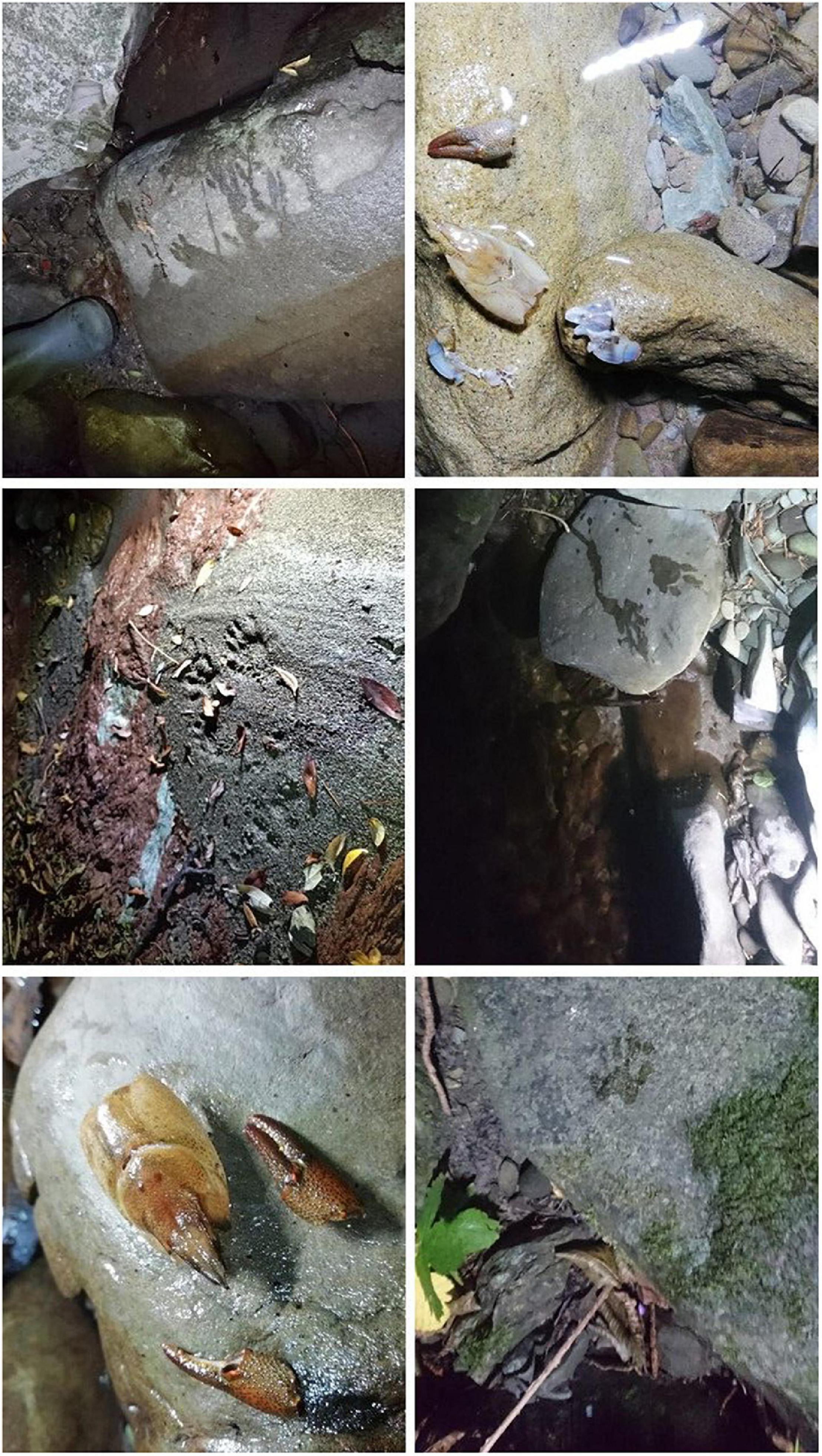
Figure 4. Fresh footprints of raccoons and predated Austropotamobius pallipes complex specimens in the study area. Photos by© G. Mazza.
Discussion
The invasive population of the raccoon in Central Italy is exponentially increasing its range (Boscherini et al., 2020; Boncompagni et al., 2021). In our study area, raccoons show a wide ecological plasticity, mostly selecting the immediate surroundings of watercourses for feeding and for denning; moreover, its dispersal is associated with rivers and valleys, which may increase the risk for crustaceans (Puskas et al., 2010; Mori et al., 2015; Mazzamuto et al., 2020). The raccoon has been found to actively predate on A. pallipes (Boncompagni et al., 2021), and our study confirms the impact of this invasive mammal on native crayfish: indeed, where the species is present, crayfish disappeared or their populations have been dramatically reduced in number, affecting their size distribution. We excluded other factors being responsible of this decline, because droughts or events of pollution were not reported, and four out of six impacted sites are also isolated and far away from human settlements (so not reachable for illegal harvesting) and with a population skewed to juveniles (that could not be the effect of a crayfish plague event). Moreover, we excluded that crayfish were preyed upon by native species (e.g., badgers, polecats, wild boars, herons, and red foxes), as this mortality rate has never been recorded before raccoon invasion (Mazza et al., 2011), when badgers and foxes were already abundant in the area. In Fosso di Camaldoli, Ponte Biforco, an abundant population of crayfish was reported in 2019 (G. Mazza, pers. comm.); and similarly, in Torrente Archiano, the presence of crayfish was detected until 2017 (A. Zoccola, pers. comm.). For these two sites, close to urban settlements, we did not consider the illegal poaching as a cause because several individuals of P. lotor were observed by local people and its fresh footprints and above all predated specimens of A. pallipes were reported during our survey (Figure 3 and Table 1). An episode of crayfish plague could not be completely discarded, even if only one event of crayfish plague was reported and far from these sites (T. Pretto, pers. comm.). Thus, the presence of raccoon weighs in favor of its impact (but the mammal could have transported the plague as well; see the conclusions). As showed by Boncompagni et al. (2021) and in our study (Table 1), the raccoon predates on medium-large individuals, which are the reproductive ones: indeed, in Fosso Forconali, Fosso dei Pianelli, and Fosso della Lama where in 2019 many predated adult crayfish were found (Boncompagni et al., 2021), only few individuals, mostly juveniles, have been sampled. Indeed, in these water courses, the CPUE sharply decreased through years (48 crayfish per hour in 1999: Cenni, 2001; 45 crayfish per hour in 2008–2009: Mazza et al., 2011; 22 crayfish per hour in 2019: Boncompagni et al., 2021). Considering that the native crayfish starts reproducing after 3 years, it is evident that these affected populations could disappear if management measures (i.e., controlling the raccoon) to protect them would not be considered. Studies conducted in central Spain (García et al., 2012) and in the United States (Byrne and Chamberlain, 2012) detected raccoon eating crayfish as well as predated crayfish and raccoon tracks, confirming that this crustacean is an important food source for the species and supporting the findings of the present study. Crayfish are also absent from Fiume d’Isola and Fosso Abetiolo, where the raccoon is not present: this could be due to these sites’ environmental characteristics, because they are very narrow and not deep streams (water depth is less than 10 cm) without pools, but no previous surveys have been conducted to confirm this hypothesis.
Populations of crayfish are still abundant in Bidente di Campigna (CPUE in 2008–2009: 122 crayfish per hour; Mazza et al., 2011) and even increased in Laghetto di Metaleto (CPUE in 2012: 26 crayfish; Mazza et al., 2012; CPUE in 2016 and 2017: 35 and 38 crayfish, respectively, G. Mazza, unpublished data) and Torrente Corsalone upper part, Siregiolo (CPUE in 2015: 22 crayfish per hour; Mazza et al., 2017). In these sites, the raccoon is absent; moreover, Laghetto di Metaleto, being fenced and deep, permits the survival of this endangered crayfish. Concerning Fosso di Campo alla Sega, we do not have previous data, on crayfish as it was the first time that the species was sampled.
Our study confirms the co-occurrence of native crayfish and crabs in Corsalone stream found by Mazza et al. (2017) with similar distribution, CPUE, and size of sampled animals, highlighting that this co-occurrence is stable through time and that when the two species are present in the same watercourse, crabs and crayfish tend to occupy the lower and upper parts, respectively.
No reliable data on the population size of raccoon are available, although Boscherini et al. (2020) presented several records in this area. Additionally, data on impacts are scattered and concern predation on pets, livestock, and recently the indigenous crayfish. It could be interesting to evaluate its feeding activity on native crab present in the National Park. Thus, monitoring of established raccoon populations and early detection of new nuclei require particular attention and should be constantly carried out. Unfortunately, since 2015, few management actions (e.g., capture of few individuals) have been conducted to control the raccoon. Thus, urgent actions (e.g., control of raccoons, monitoring of A. pallipes populations, and a recovery through restocking activities where possible) should be taken into account to guarantee the survival of this crayfish species, which is protected according to national and international laws. Moreover, considering the presence of the red swamp crayfish and fast spread of the raccoon, the possibility that this invasive mammal can carry the crayfish plague should be assessed. It would be also relevant to analyze raccoon’s scats and stomach content (if dead specimens are available) to definitively support our findings. In conclusion, the introduction of raccoons appears to have caused a decrease in the native crayfish populations: these invasive mammals currently constitute a major risk factor for the survival of the crayfish species in this area, already threatened by several other factors (Mazza et al., 2011, 2017). Management actions are mandatory; otherwise, as narrated in the Indian Legend “Raccoon and the Crawfish” (Holmgren, 1990)1, the destiny of the crayfish is already written, and the risk of losing several populations of this crustacean will become a reality.
Data Availability Statement
The original contributions presented in the study are included in the article/supplementary material, further inquiries can be directed to the corresponding author/s.
Author Contributions
ET conceived the study and collected and analyzed the field data. GM conceived the study and collected the field data. ET and GM led the manuscript writing. LD collected and inserted the field data. SM, LP, BR, and AZ collected the field data. PC planned the sampling and provided funding. All authors contributed critically to the draft and gave final approval for submission.
Funding
This study has been financed by Reparto Carabinieri Biodiversità (Stia, Arezzo, Italy).
Conflict of Interest
The authors declare that the research was conducted in the absence of any commercial or financial relationships that could be construed as a potential conflict of interest.
Publisher’s Note
All claims expressed in this article are solely those of the authors and do not necessarily represent those of their affiliated organizations, or those of the publisher, the editors and the reviewers. Any product that may be evaluated in this article, or claim that may be made by its manufacturer, is not guaranteed or endorsed by the publisher.
Acknowledgments
We warmly thank operaio OTD Andrea Ciani and Alessandro Tondo for their help during the sampling sessions. This paper is dedicated to our friend Alessandro Elio Agnelli who recently passed away and loved this National Park and Corsalone stream.
Footnotes
References
Abell, R. (2002). Conservation biology for the biodiversity crisis: a freshwater follow-up. Conserv. Biol. 16, 1435–1437. doi: 10.1046/j.1523-1739.2002.01532.x
Alonso, F., Temiño, C., and Diéguez-Uribeondo, J. (2000). Status of the white-clawed crayfish, Austropotamobius pallipes (Lereboullet, 1858), in Spain: distribution and legislation. Bull. Fr. Pêche Piscic. 356, 31–53. doi: 10.1051/kmae:2000003
Aquiloni, L., Tricarico, E., and Gherardi, F. (2010). Crayfish in Italy: distribution, threats and management. Int. Aquat. Res. 2, 1–14.
Boncompagni, L., Molfini, M., Ciampelli, P., Fazzi, P., Lucchesi, M., Mori, E., et al. (2021). No country for native crayfish: importance of crustaceans in the diet of native and alien Northern raccoons. Ethol. Ecol. Evol. doi: 10.1080/03949370.2021.1872710
Boscherini, A., Mazza, G., Menchetti, M., Laurenzi, A., and Mori, E. (2020). Time is running out! Rapid range expansion of the invasive northern raccoon in central Italy. Mammalia 84, 98–101. doi: 10.1515/mammalia-2018-0151
Bottacci, A. (2009). La Riserva Naturale Integrale di Sasso Fratino: 1959-2009. 50 Anni di Conservazione Della Biodiversità [The Natural Reserve of Sasso Fratino: 1959-2009. 50 Years of Biodiversity Conservation]. Arezzo: CFS/UTB Pratovecchio Editions.
Byrne, M., and Chamberlain, M. J. (2012). Using first-passage time to link behaviour and habitat in foraging paths of a terrestrial predator, the racoon. Anim. Behav. 84, 593–601. doi: 10.1016/j.anbehav.2012.06.012
Cenni, F. (2001). Austropotamobius Pallipes nel Parco Nazionale Delle Foreste Casentinesi, Monte Falterona e Campigna: Struttura di Popolazione e Tasso di Infestazione da Branchiobdellidi [Austropotamobius Pallipes in the Foreste Casentinesi, Monte Falterona and Campigna National Park: Population Structure and Infestation Rate by Branchiobdellids]. Ph.D. thesis. Florence: Università degli Studi di Firenze.
Chucholl, C. (2016). The bad and the super-bad: prioritising the threat of six invasive alien to three imperilled native crayfishes. Biol. Invasions 18, 1967–1988. doi: 10.1007/s10530-016-1141-2
Füreder, L., Gherardi, F., Holdich, D. M., Reynolds, J. D., Sibley, P., and Souty-Grosset, C. (2010). Austropotamobius pallipes. The IUCN Red List of Threatened Species. Version 2014.3. Available online at: https://www.iucnredlist.org (accessed July 1, 2021).
García, J. T., García, F. J., Alda, F., Gonzalez, J. L., Aramburù, M. J., Cortès, Y., et al. (2012). Recent invasion and status of the raccoon (Procyon lotor) in Spain. Biol. Invasions 14, 1305–1310. doi: 10.1007/s10530-011-0157-x
Holmgren, V. C. (1990). Raccoons: In folklore, History & Today’s Backyards. Santa Barbara, CA: Capra Press, 157.
Kozak, P., Fureder, L., Kouba, A., Reynolds, J., and Souty-Grosset, C. (2011). Current conservation strategies for European crayfish. Knowl. Manag. Aquat. Ec. 401:1. doi: 10.1051/kmae/2011018
Manenti, R., Ghia, D., Fea, G., Ficetola, G. F., Padoa-Schioppa, E., and Canedoli, C. (2019). Causes and consequences of crayfish extinction: stream connectivity, habitat changes, alien species and ecosystem services. Freshw. Biol. 64, 284–293. doi: 10.1111/fwb.13215
Mazza, G., Agostini, N., Aquiloni, L., Carano, G., Inghilesi, A. F., Tricarico, E., et al. (2011). The indigenous crayfish Austropotamobius pallipes complex in a national park of central Italy. Knowl. Manag. Aquat. Ec. 401:24. doi: 10.1051/kmae/2011041
Mazza, G., Bottacci, A., Cianferoni, F., Rocchi, S., Rossi, B., Terzani, F., et al. (2012). “Il gambero di fiume (Austropotamobius pallipes complex) nella Riserva naturale biogenetica di Camaldoli,” in La Riserva Naturale Biogenetica di Camaldoli. 1012-2012. Mille Anni di Rapporto Uomo-Foresta, ed. A. Bottacci (Arezzo: CFS/UTB Pratovecchio), 317–321. doi: 10.4129/ifm.2012.4.01
Mazza, G., Tricarico, E., Cianferoni, F., Stasolla, G., Inghilesi, A. F., Zoccola, A., et al. (2017). Native crab and crayfish cooccurrence: first evidence in Europe. Biologia 72, 790–795. doi: 10.1515/biolog-2017-0086
Mazzamuto, M. V., Panzeri, M., Bisi, F., Wauters, L. A., Preatoni, D., and Martinoli, A. (2020). When management meets science: adaptive analysis for the optimization of the eradication of the Northern raccoon (Procyon lotor). Biol. Invasions 22, 3119–3130. doi: 10.1007/s10530-020-02313-6
Mori, E., Mazza, G., Menchetti, M., Panzeri, M., Gager, Y., Bertolino, S., et al. (2015). The masked invader strikes again: the conquest of Italy by the Northern raccoon. Hystrix 26, 47–51.
Petralia, L., Lucchesi, M., and Zoccola, A. (2019). Segnalazioni faunistiche, 181 – Potamon fluviatile fluviatile Herbst, 1785 (Crustacea: Decapoda: Potamidae) [Faunistic records, 181 – Potamon fluviatile fluviatile Herbst, 1785 (Crustacea: Decapoda: Potamidae)]. Quad. Studi. Nat. Romagna 50, 202–203.
Pratten, D. J. (1980). Growth in the crayfish Austropotamobius pallipes (Crustacea: Astacidae). Freshw. Biol. 10, 401–402. doi: 10.1111/j.1365-2427.1980.tb01215.x
Puskas, R. B., Fischer, J. W., Swope, C. B., Dunbar, M. R., McLean, R. G., and Root, J. J. (2010). Raccoon (Procyon lotor) movements and dispersal associated with ridges and valleys of Pennsylvania: implications for rabies management. Vector Borne Zoonotic Dis. 10, 1043–1048. doi: 10.1089/vbz.2009.0079
Ragni, B., Vercillo, F., and Grelli, D. (2015). Studio su Carnivori di Interesse Conservazionistico e Gestionale Nell’Area del Parco [Study on Carnivores of Conservation and Management Concern Within the Park Area]. [Technical Report]. Arezzo: Ente Parco Nazionale delle Foreste Casentinesi.
Reynolds, J., Souty-Grosset, C., and Richardson, A. (2013). Ecological roles of crayfish in freshwater and terrestrial habitats. Freshw. Crayfish 19, 197–218.
Richman, N. I., Boehm, M., Adams, S. B., Alvarez, F., Bergey, E. A., Bunn, J. J. S., et al. (2015). Multiple drivers of decline in the global status of freshwater crayfish (Decapoda: Astacidea). Philos. Trans. R. Soc. Lond. B Biol. Sci. 370:20140060. doi: 10.1098/rstb.2014.0060
Keywords: Austropotamobius pallipes complex, Foreste Casentinesi, Monte Falterona and Campigna National Park, Procyon lotor, predation, Potamon fluviatile, population decrease
Citation: Tricarico E, Ciampelli P, De Cicco L, Marsella SA, Petralia L, Rossi B, Zoccola A and Mazza G (2021) How Raccoons Could Lead to the Disappearance of Native Crayfish in Central Italy. Front. Ecol. Evol. 9:681026. doi: 10.3389/fevo.2021.681026
Received: 15 March 2021; Accepted: 16 July 2021;
Published: 11 August 2021.
Edited by:
Kathrin Theissinger, LOEWE Centre for Translational Biodiversity Genomics (LOEWE-TBG), GermanyReviewed by:
Lucian Pârvulescu, West University of Timişoara, RomaniaChristoph Chucholl, Fischereiforschungsstelle Baden-Württemberg, Germany
Anne Schrimpf, University of Koblenz and Landau, Germany
Copyright © 2021 Tricarico, Ciampelli, De Cicco, Marsella, Petralia, Rossi, Zoccola and Mazza. This is an open-access article distributed under the terms of the Creative Commons Attribution License (CC BY). The use, distribution or reproduction in other forums is permitted, provided the original author(s) and the copyright owner(s) are credited and that the original publication in this journal is cited, in accordance with accepted academic practice. No use, distribution or reproduction is permitted which does not comply with these terms.
*Correspondence: Elena Tricarico, ZWxlbmEudHJpY2FyaWNvQHVuaWZpLml0
†ORCID: Elena Tricarico, orcid.org/0000-0002-6644-1429; Giuseppe Mazza, orcid.org/0000-0002-6644-1429
 Elena Tricarico
Elena Tricarico Paola Ciampelli2
Paola Ciampelli2 Lorenzo Petralia
Lorenzo Petralia Giuseppe Mazza
Giuseppe Mazza